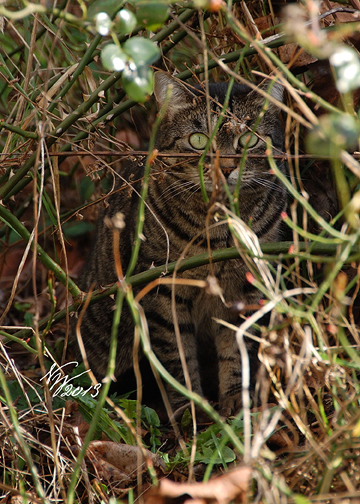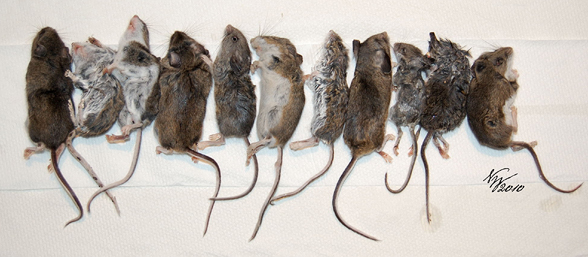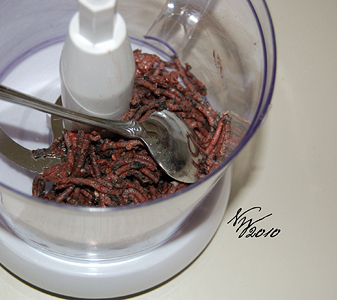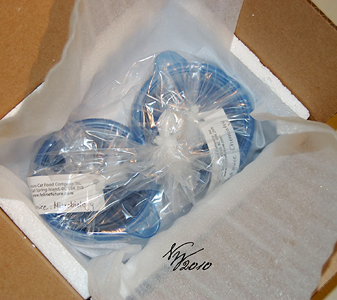Reinventing the Mouse
Each living thing on our planet has adapted to thrive in its own unique environment, and has become specialized in using a specific resource as food to fuel its own survival and that of its kind.
What exactly is the unique environment of cats or what have they specialized in eating?
Pet food companies base their formulation on figures, values, and results from countless individual feed trials and experiments done over decades by many different researchers, which have been compiled in works like the “Nutrient Requirements of Dogs and Cats” published by the National Research Council. This kind of work obeys entirely by the “scientific method” to assure precision and accuracy. Unfortunately, it comes at a great expense, which is the lives of thousands of cats who have been experimented on in the controlled environment of the laboratory, and have died to give us this information. While the information is very valuable, the means by which it was obtained is not ethical, even if it is meant to serve the greater good.
A less scientific method that can be employed to learn about the natural diet of cats and their nutritional requirements are observational studies. Before the results of scientific experiments had ever been published, nature had already provided us with a precise blue print of cat nutrition.
It starts with the taxonomy of species, and is supported by modern DNA research, which enable us to find the wild equivalent of our domestic cats and provide us with the fact that domestic cats remains genetically unaltered from its ancestor. This means that our domestic cats (Felis catus) are the same as the African Wildcat (Felis lybica) except for physical appearances of the domestic cats, which are the result of enhancing mutations through purposeful inbreeding in human care.
Biologists know exactly from observations of species in nature, and the study of their scat, what each species of wild cat is most adapted to be eating. Field studies like that provide us with the fact that the African Wildcat prefers rodents as its prey throughout its range of Sub-Sahara Africa, North Africa and Southwest Asia. This means that domestic cats – a domestic version of the African Wildcat – are also rodent hunters.
Modern nutritional analysis can provide a complete breakdown of foods. A complete nutritional analysis of rodents would, therefore, shed considerable light on the nutritional requirements of domestic cats. Simple feed trials, and even field studies, would answer the question how much food (how many mice per day) cats need to consume to fuel survival, activity, reproduction, and growth of their offspring. This figure would then provide a very good idea of how much of each nutrient is required by cats per day based on the assumption that the natural diet is the ideal diet for cats, because cats have adapted to their prey over millions of years.
Together, this knowledge forms a very precise answer to perfect nutrition for domestic cats. Innovation comes into play when recreating a diet of rodents nutritionally with foods commonly used in modern human culture. Because modern cat owners are rather turned off by the idea of serving their feline companions four or five mice each every day, I made it my motto to “reinvent the mouse” with meats and supplements for ultimate feline nutrition. The raw meat diet resulting from my efforts offers a practical and satisfactory alternative to the cat’s natural diet of prey.
The less scientific method of studying the nutrient requirements of cats does not provide answers about minimum requirement and potential toxic effects of nutrients if given in larger than natural quantities. While this information satisfies our curiosity, it is not necessary for formulating foods for cats unless one desires to formulate foods from cheap resources and by-products. A manufacturer may want to know how much cheap filler he can put into his cat food without causing harm, and by how much he can cut the expensive ingredients without causing harm.
“The Mouse Project” – Nutritional analysis of wild mice
In August of 2008 I began collecting wild rodents for a nutritional analysis in order to have data for a real comparison of my raw meat cat food formula to the cats real natural prey diet. I decided to use wild rodents, because I did not want the content of the digestive tract of captive raised domestic rodents to negatively influence the nutritional analysis. Also, I knew little about the natural diet of mice and other rodents. A diet deficient for them or with unnatural excess could have caused sub clinical disease in the domestic rodents which could have been reflected in the nutritional analysis of their tissue without my awareness and giving me untrue results.
The rodents which I collected on location on our farm in British Columbia were the native Deer Mouse (Peromyscus maniculatus) and the native Meadow Vole (Microtus pennsylvanicus). Neither is related to the House Mouse (Mus musculus). The House Mouse has likely been the predominant prey of cats since domestication, while the pet Gerbil (Meriones unguiculatus) is probably most similar to the rodent species of Africa which are hunted by the African Wildcat. Because my objective was the analysis of WILD rodents, I did not make use of readily available captive-bred House Mice or Gerbils, however.
The Deer Mice for the analysis were caught in mouse traps and by some of my cats, while all voles were caught by one of my cats. Only absolutely fresh specimens were used. They were weight, dated, cataloged, and then bagged and frozen whole immediately. Although I had collected enough specimens of both kinds of rodents by the end of September 2008, I decided to prepare only the mice for nutritional analysis due to financial restraints.
In March of 2010, the mice were ground whole while frozen, portioned for analysis, labeled, and returned immediately to the freezer. They were shipped in an insulated container via courier service to the laboratory. Two separate portions of the same sample were supplied, because the laboratory insisted on a microbiology analysis to determine if the material should be considered hazardous. The results from the microbiology analysis are of great interest in light of cats eating mice as they are -whole and raw.
The nutritional analysis of the wild caught mice sample included the macro nutrients protein, fat, carbohydrates, as well as moisture and total ash. In addition, a complete scan of all minerals and trace minerals was done, which included iodine as a special order. Taurine and Vitamin A and E were also analyzed. The microbiology analysis included a Coliform and E.coli plate count, Listeria mono, Salmonella, and Staph. aureus.
The results from having analyzed the wild Deer Mice were then compared with available data of basic nutrient compositions of vertebrate prey, which included domestic mice, fed in zoos. Of course, and most importantly, the analysis results were then compared with my raw meat cat food formula. The analysis of the wild Deer Mice confirmed the suitability of my formula as a staple food for cats, because the nutrient compositions were extremely similar to each other. The analysis of the wild mice enabled me to fine-tune the raw cat food formula based, but no significant changes were necessary.




